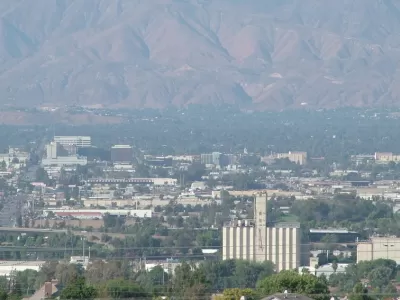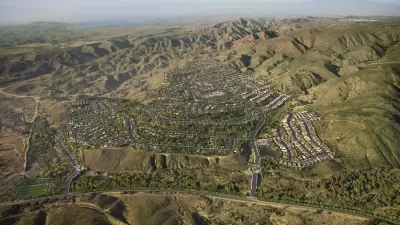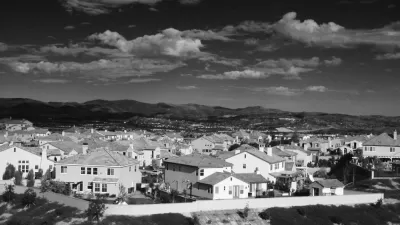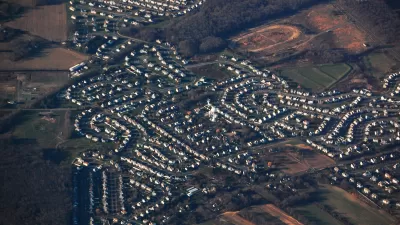The focal point of California's vast Inland Empire, the suburban city of San Bernardino was brought to its knees by the Great Recession. Its civic bankruptcy and its emergence as a suburban slum is perhaps America's most tragic story of urban sprawl.

If you had to choose between being Detroit and being San Bernardino these days, it might be a toss-up. In fact, you might choose Detroit. Though the Rust Belt giant has famously suffered through decay, decline, and the country's largest civic bankruptcy, its bones remain strong and its spirits are rising. As Detroit's suburban, West Coast counterpart, San Bernardino may yet have a ways to fall. Already rocked by local economic shocks, such as the closing of a nearby Air Force base, many of its 210,000 residents became classic victims of the mortgage crisis and Great Recession of the late 2000s.
With so many homes underwater and a relatively homogenous economic base, San Bernardino was ill-equipped to weather such a huge shock. In its recent profile of San Bernardino, the Los Angeles Times called it "the poorest city of its size in the state and a distillation of America’s urban woes." By some measures, among the country's 100 biggest cities, only Detroit is poorer. Just two months ago, the city finally approved a plan to stabilize the city's finances, by raising taxes and cutting services.
"San Bernardino also had its curses. This rail and highway crossroads at the edge of the Los Angeles metropolis attracted hobos, misfits and con men selling cheap land. The Hells Angels roared to life in the area in the 1950s. As the valley became the region’s downwind cul-de-sac for some of the worst smog in the nation, the looming mountains disappeared and lungs burned. Over the last three decades, the economy imploded. The rail shops and the nearby steel plant closed. So did Norton Air Force Base, costing the city 12,500 jobs. Downtown businesses vacated. Law offices decamped to Riverside when the federal bankruptcy and state appellate courts moved."
"When the recession hit, San Bernardino’s foreclosure rate was 3.5 times the national average. It was inevitable: Only 46% of San Bernardino’s working-age residents have jobs — the lowest figure in the state for cities anywhere near its size. And so the statistical landslide built momentum as property and sales taxes fell by more than a third in recent years."
By some measures, San Bernardino keeps getting worse, and more blighted.
"Unlike the explosive push driving people from hollowed-out Rust Belt cities, San Bernardino’s economic implosion is sucking people in: immigrants, parolees, Los Angeles gang members and those like the Lopezes, who can’t afford to live anywhere else in California."
FULL STORY: San Bernardino: Broken City

Planetizen Federal Action Tracker
A weekly monitor of how Trump’s orders and actions are impacting planners and planning in America.

Restaurant Patios Were a Pandemic Win — Why Were They so Hard to Keep?
Social distancing requirements and changes in travel patterns prompted cities to pilot new uses for street and sidewalk space. Then it got complicated.

Map: Where Senate Republicans Want to Sell Your Public Lands
For public land advocates, the Senate Republicans’ proposal to sell millions of acres of public land in the West is “the biggest fight of their careers.”

Maui's Vacation Rental Debate Turns Ugly
Verbal attacks, misinformation campaigns and fistfights plague a high-stakes debate to convert thousands of vacation rentals into long-term housing.

San Francisco Suspends Traffic Calming Amidst Record Deaths
Citing “a challenging fiscal landscape,” the city will cease the program on the heels of 42 traffic deaths, including 24 pedestrians.

California Homeless Arrests, Citations Spike After Ruling
An investigation reveals that anti-homeless actions increased up to 500% after Grants Pass v. Johnson — even in cities claiming no policy change.
Urban Design for Planners 1: Software Tools
This six-course series explores essential urban design concepts using open source software and equips planners with the tools they need to participate fully in the urban design process.
Planning for Universal Design
Learn the tools for implementing Universal Design in planning regulations.
Heyer Gruel & Associates PA
JM Goldson LLC
Custer County Colorado
City of Camden Redevelopment Agency
City of Astoria
Transportation Research & Education Center (TREC) at Portland State University
Camden Redevelopment Agency
City of Claremont
Municipality of Princeton (NJ)





























